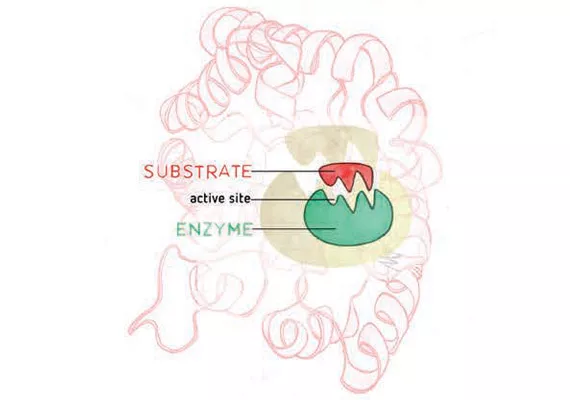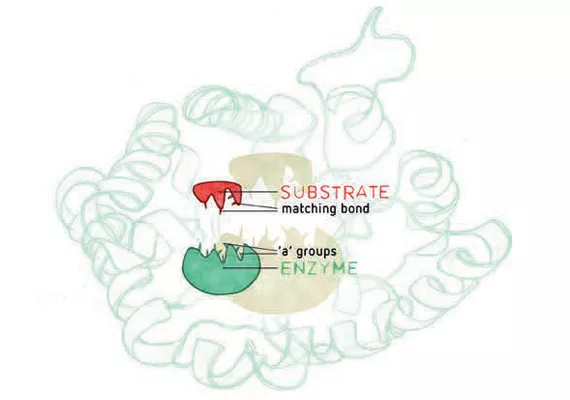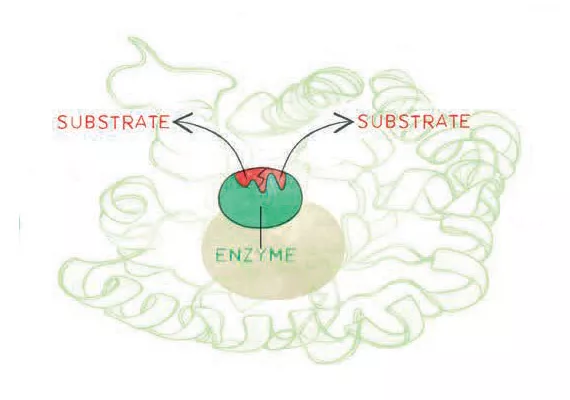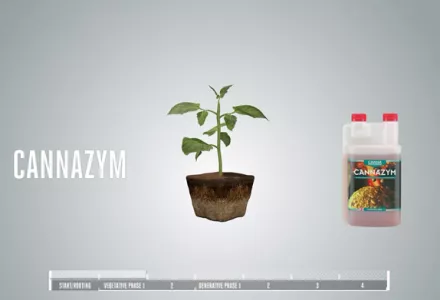In the world of plant nutrients and supplements, you can find all sorts of weird and wonderful liquids and powders scattered across the shelves of your local shop. It is most common for a grower to select nutrients and flowering supplements based on their nutritional content. Whether it is the base nutrients chosen directly on NPK values or additives supplementing p/k or cal/mag, these inputs easily translate to a grower in terms of what benefit they are directly going to see in their cherished plant. You’d be crazy not to buy these things right? you know your plant physically needs them.
Not such an obvious choice for a modern grower are products that have less direct and maybe not quite as obvious results, but still offer a wide range of key plant benefits that you would be wise not to dismiss. Enzymes are one of the best examples of this. It’s not the sort of product where a grower can easily visualise what benefit they are actually going to get. Well, let’s break that shadowy veil of mystery shall we? Follow us down the path of enlightenment as we look at exactly what enzymes are, and just how you can make the most of them.
What are they?
You can consider them to be little bio-chemical helpers. Tiny little protein based missionaries going around in life with the sole purpose of helping out other molecules to perform their various tasks. We can all relate to that surely? We all need a bit of help now and again don’t we? For example: If you didn’t have help filling out your government benefit forms then you wouldn’t get any extra money to go down the pub with. Obviously these proteins aren’t going around filling out forms though, they have a lot more complex tasks ahead of them.
What do they do?
Enzymes play the role of a catalyst in almost every bio chemical reaction that occurs. They speed up these reactions by lowering the activation energy required by the substrate to react. As an example: Your body’s ability to digest and break down food into a source of nutrient your body can actually uptake, relies on enzymes. Without their presence this process would happen so slowly you would very quickly be dead from malnutrition, regardless of how much food you swallow; No amount of protein shakes or energy drinks would be able to save you.
Yeah ok, but what actually are they?
Generally speaking, enzymes are made up of proteins and then if required, a partner group of molecules.
The proteins are made up from chains of amino acids. Although strictly speaking, in the formation of these chains they become amino acid residues as they lose a water molecule each time a bond occurs.
The partner group will be either:
- Co-Factors - Molecules (like Iron or Zinc ions) that increase the rate of reactions.
- Co-Enzymes - Organic molecules (commonly derived from vitamins) that bind loosely to enzymes and help them function. Prosthetic Group Organic molecules or metal ions that are bound extremely tightly to the enzyme, often by a covalent bond.

How do they actually work?
The protein chains and co-factors described earlier can be combined in all sorts of weird and wonderful shapes. It is this shape and its unique three dimensional structure that plays a major part in the role of the resultant enzyme. Each different enzyme has its own unique active site. It is these active sites that provide the base for the enzymes function.
This is what is known as the ‘Lock and Key’ principle. As each enzyme has a unique three dimensional structure it also has its own unique active site (the lock) and will only react with a correspondingly shaped substrate (the key). Just as important as the physical shape of this active site, is the amount and type of available bonding sites it has along its surface. As you know, the active site is composed from long chains of amino acid residues. Well, the amino acids that form these chains in turn have their own side groups of amino acids sticking out them, referred to as ‘R’ Groups. It is not only the amount (commonly between 3 and 12) but also the type of ‘R’ Groups that an active site has that dictates how it will react with a substrate.
So, once the substrate is positioned perfectly in the Active Site (and formed the necessary bonds with the required ‘R’ groups) the enzyme gives a slight chemical based nudge on the substrate. For example a slight change in pH may be all that is needed. What this little biochemical poke does is lower the activation energy for the reaction and allow the substrate to break apart into its products.
A classic example that most hydroponic enthusiasts will be familiar with is Hydrogen Peroxide (H2O2). H2O2 breaks down into Water (H2O) and Oxygen (O2) thanks to the enzyme called Catalase.
It’s almost like a jigsaw puzzle but with a major plot twist at the end: You’ve spent ages with the final few pieces, but for the life of you can’t get them to fit. Finally you give up and go on Youtube to see how to do it. With this catalytic information you are able to quickly complete it and bask in all its magnificent glory. However, as you place the last piece the whole board shatters back into its separate pieces, ready to be used all over again.
You can probably guess that you need to be very selective when producing an enzyme intended for a particular purpose. Each specific enzyme is only capable of providing the catalyst for one specific reaction. It needs to have precisely the right shaped active site, correct amounts of ‘R’ bonds and have the right partner group or it will catalyse nothing. If any of these are not correct, then you have a useless enzyme and might as well not bother applying it. As a pertinent example for plant cultivation: they need to break down not only the dead cells walls, but also the pectin that binds these cells together.
Practical benefits in cultivation with enzymes
You’re probably thinking: “All that sciencey stuff is all well and good, but what does it actually mean for me and my garden? I don’t care about Active sites and ‘R’ Groups, I want to know what benefits my prize winning Begonias actually going to see from using them” Well, the answer to this centres on certain enzymes abilities to increase the rate at which organic matter is decomposed. On the face of it, this sounds like quite a trivial process but is one that can have significant knock on effects to the overall performance of your crop in a variety of ways.

Improved nutrient cycling
This is possibly the most obvious and advantageous benefit enzymes can provide to your plants. Your plants need nutrients. That much you can be certain of! You wouldn’t spend hundreds of pounds on bottles of liquids to pour over them if they didn’t. It isn’t just that bottle of liquid that can be a source of food for your plant though. Locked away inside your growing media is a wealth of nutrition that just needs a particular nudge in the right direction for it all to be made accessible to your plants again.
Organic matter, decaying plant material and mineral salt deposits can all broken down by enzymes and converted back into a plant available format.
Promotes the growth of beneficial bacteria/fungi
On top of producing nutrients from the breakdown of dead roots, natural sugars are also released back into the growing media. These sugars mostly come from the decomposition of the pectin between the dead roots cell walls and require very particular enzymes to do this. The resultant natural sugars provide beneficial biology with the ideal food source to continue their proliferation and help you maintain a happy, healthy root zone.
Prevents against deadly pathogens
A rapid breakdown and subsequent conversion of dead and rotting organic matter in a root zone will significantly reduce your plants risk to contracting a disease. Dead roots and decomposing organic matter are the food sources on which many pathogens will use to gain a foothold in your pot. They will usually begin with this dead material in order to build up the energy to then go on to attack an otherwise healthy plant. By removing this initial food source, they will not be able to take hold so easily, thus leaving your plant in a nice and healthy state.
Promotes healthy root growth
With the increased proliferation of beneficial bacteria in your growing media, you will also reap the rewards of the associated increase in root growth and development. However, it is not just the greater microbe population that will increase root growth: The inclusion of certain vitamins that make up the co-enzymes promote the production of particular hormones in the rhizosphere, and help to push root growth to the limits.

Maintains soil structure and integrity
The rapid breakdown and removal of decomposing material keeps everything nice and clean in your pot. Not only that but it means no space is being unnecessarily taken up with dead and decomposing organic matter. With less physical matter in the pot a proportionally higher level of aeration can be expected, once again encouraging a healthy and productive root zone. This is particularly important for growers who choose to re-use their growing media for successive crops: transforming a spent root ball back to a useable state is effortlessly achieved with the use of enzymes.
Break it all down for me
Besides creating opportunities for outrageously hilarious puns like the title of this paragraph, there are all sorts of positive affects the use of enzymes can have on your crop. We have highlighted a few of them here but this is by no means where the list ends. The sort of advantages you can have from using an exceptional enzyme product aren’t quite as tangible as say a bloom booster may be, but that does not necessarily mean that they are any less important.
Hopefully now the question on the tip of your tongue will not be whether you should use an enzyme product: It should now be beyond doubt that your plants will thank you for using one. The question you should now be asking yourself is what enzyme product you should be using. No doubt you have seen a lot on the shelves of your local store and choosing which one to invest both money and time in can be a spurious task.
Above all, you need to be certain of its effectiveness. Fortunately, there is a very simple way in which you can test this for yourself. For the full method you can watch one of our top scientists show you how (we do let them out occasionally). All you need are some cups, paper, apple sauce, water and your chosen enzymes. In no time at all you will be grading your enzymes like a connoisseur and only allowing the finest of them to grace your grow room.


